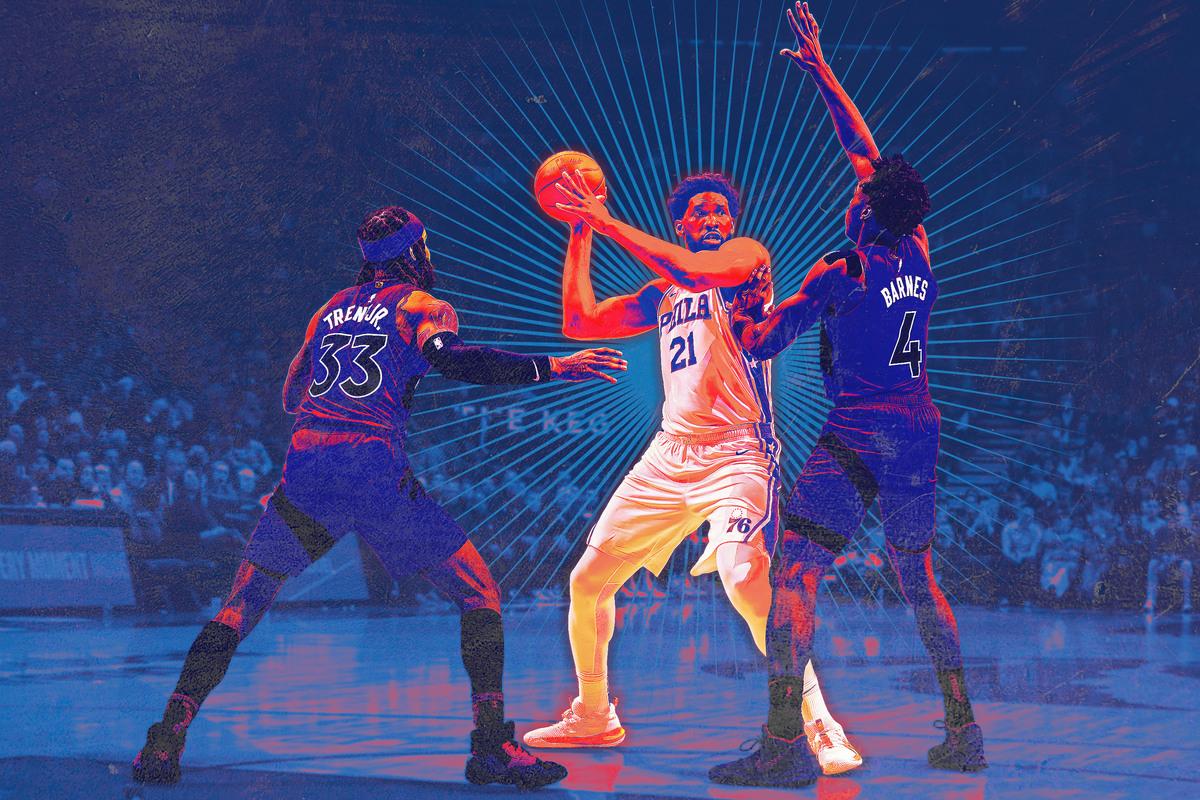
There are countless ways for Joel Embiid to put his dominance on display. He’s pretty much always the largest, most intimidating person on the court, with a polished jumper, the dexterity of a ballet dancer, and the ability to draw contact and send himself to the free throw line whenever he wants.
Embiid’s talent now equals what we’d see if we could merge prime Shaquille O’Neal and Kobe Bryant into the same body. There’s enough power and skill to virtually guarantee something good if he’s granted an opportunity to attack one-on-one. The common-sense reaction by the NBA’s 29 other teams when that happens is to load up, show bodies, and send lots of help from different angles, with different players, and at different junctures. It’s here, in these pockets of time and space, that Embiid’s at his most appealing, fierce, and vulnerable.
This season, nobody has drawn more double-teams out of isolation and post-ups than Embiid, per Second Spectrum. (Nikola Jokic ranks second on post-ups and Giannis Antetokounmpo is second in isolation.) Yet even though he’s in his seventh season, and has repeatedly dealt with the same coverages over and over again, how Embiid reacts to all that attention remains the most exciting and revealing part of his game.
Basketball is lightning fast and dictated by several basic tenets. One being: When multiple defenders swarm a ball handler, the ball handler should probably pass it to whoever’s open. Punish your opponent by taking what they give. Unlike Jokic—whose favorite thing about the sport might be dishing out of a double-team—Embiid defies this rule as much as anyone, often sizing up two-on-one confrontations with the not-necessarily-wrong belief that he can either muscle through or pull up over the top. It’s easy to appreciate his determination in these spots as the cross-section between unbridled confidence, physicality, and necessary aggression. Regardless of how open they are, how can anyone else, no matter the context, be a better option than he is?
It’s also fair to spot a slight defect in this approach. “I don’t need to be passing the ball and making plays for my teammates the whole game,” Embiid recently said, describing his snug fit with James Harden. “I like to score the ball, and most of the time James sets me up to do that. And when he doesn’t play, I take on that role as far as playmaking.”
There’s a contradiction in that quote. On one hand, sharing is caring. On the other hand, the gap between the right play and the wrong play that’s actually OK can be crossed with an eyelash when made by a towering superstar who has a 65.2 true shooting percentage and 37.3 usage rate. (The only other player who’s ever crossed those thresholds in the same season is Steph Curry.) Watch enough examples and it’s hard to see fault in Embiid’s thought process.
It’s almost like the level of greatness Embiid has reached is handcuffed to a nonchalant boredom that requires him to find different ways to challenge himself. He wouldn’t be the first: Michael Jordan made a few free throws with his eyes closed, Larry Bird once obliterated the Trail Blazers with his left hand.
But there’s a downside to this tactic, too. When Embiid is doubled in the post, Philly’s offense musters only 110.2 points per 100 possessions overall this season. It’s the best number of his career, and 13 points higher than last season, but it’s also about the same offensive rating as the Orlando Magic. (When he’s doubled on an isolation, the 76ers produce 111.4 points per possession—up from last year’s 102.)
Those results include shot-clock grenades and turnovers in a relatively small sample size—watching each possession unfold provides a clearer view of Embiid’s intention on any given play—but his decision-making in a crowd can sometimes be an avoidably bumpy ride. He still holds on to the ball a beat too long, when getting off it quicker could punish a defense that’s in rotation. And if you’re a process (sorry) over results person, then Embiid’s missed shots are particularly frustrating.
Some of his turnovers in these spots come from a rushed intent to score: Instead of letting a double-team happen and then involving his teammates, Embiid anticipates the help and tries to attack before it comes.
When Embiid is doubled in the post, he passes on only 44.3 percent of his direct plays. That’s the second-lowest mark among all who’ve faced at least 25 double-teams this season, per Second Spectrum. The only player in that pool who shoots at a higher frequency is Bobby Portis.
For comparison, because they are inseparable MVP candidates who yield a fascinating contrast, Jokic’s shot frequency is 6.3 percent and he ends 82.5 percent of post-up double-teams with a pass. That’s not a surprise. What may be a surprise is the stark contrast between Embiid and Antetokounmpo when they are doubled in isolation: The two-time MVP shoots only 2.9 percent of the time, while Embiid is at a whopping 32.6 percent.
This isn’t a fresh iteration of Embiid. He’s pretty much always played this way. What’s (somewhat) new this season is who’s around him. Pretty much everyone who shares the floor with Embiid can shoot. The Sixers rank first in non-corner 3-point accuracy and have an above-average 3-point rate for the first time in five seasons. Ben Simmons and Matisse Thybulle are long gone. Philly is generating 1.28 points per possession when Embiid passes out of a double-team in the post this season.
Embiid is not selfish. Only four centers have more assists than he does this season. At the end of the day, his purposeful bucket-getting is why he’s a top-five player. And when you send a double-team and it still doesn’t work, a demoralizing aftertaste lingers on an opponent’s tongue far longer than any other outcome.
The big-picture takeaway here is tattooed with circumstantial conjecture and questions that elude statistical analysis, such as: How does Embiid’s aggression affect his teammates’ urgency off the ball, knowing it’s unlikely to find them? (The Sixers rank 25th in the number of cutting floaters and layups attempted per 100 possessions this season. There are a bunch of reasons for this, but Embiid’s style doesn’t exactly encourage them.) If his usage were lower and the ball hopped around a bit more, would an offense that’s already one of the league’s best improve or become less potent?
The Sixers are a bona fide title contender, but these questions will become a more pressing concern in the playoffs, when teams have more time to plan, tweak, and execute schemes that primarily aim to slow down Philly’s bread-and-butter action: the Harden-Embiid pick-and-roll. From there, hero ball chances will likely rise for Embiid—and with them, more defensive pressure. Maybe he’s good enough to beat it by himself, despite being surrounded by the type of talent that can allow a slightly less aggressive version of Embiid to shine.
Again, you watch enough of these plays and it’s easy to believe a term like “shot quality” is fake news. But if Embiid makes marginal downshifts in key spots throughout the playoffs—i.e., solving the defense’s best-laid plan instead of trying to clobber it over the head—he may finally lead the Sixers on the type of run that, for years, has felt inevitable.

